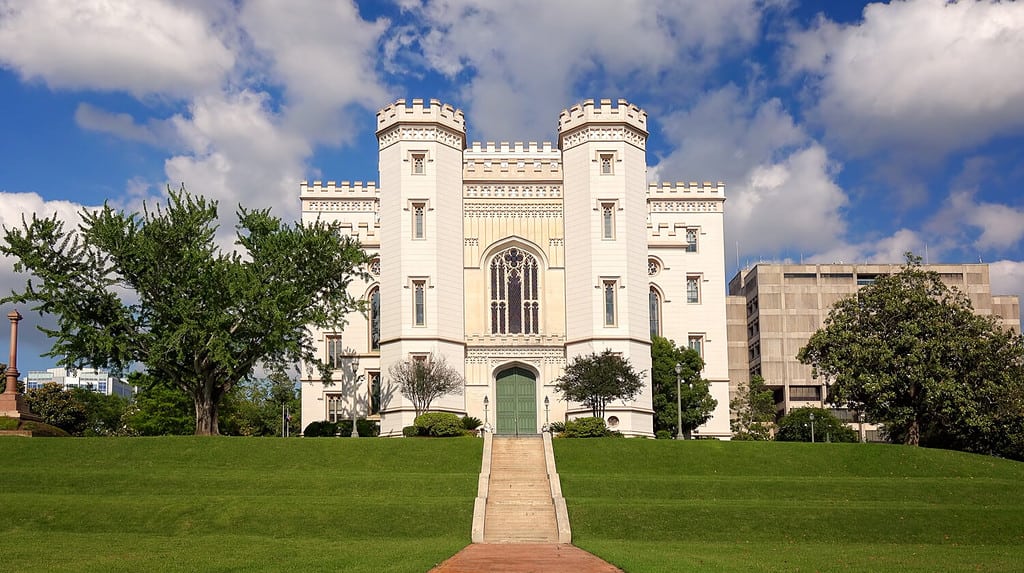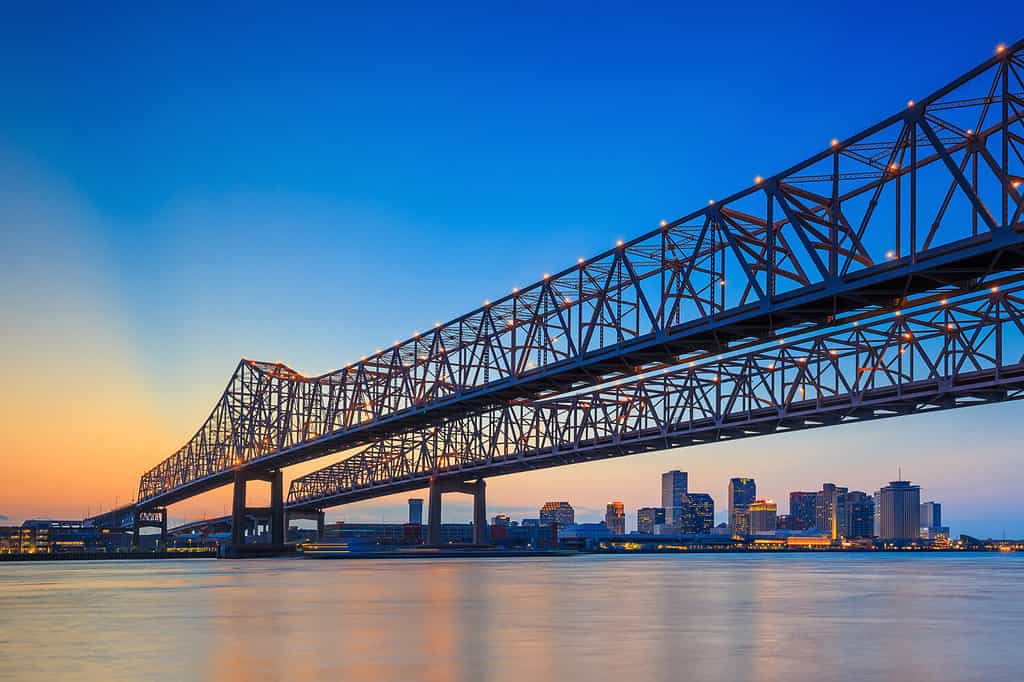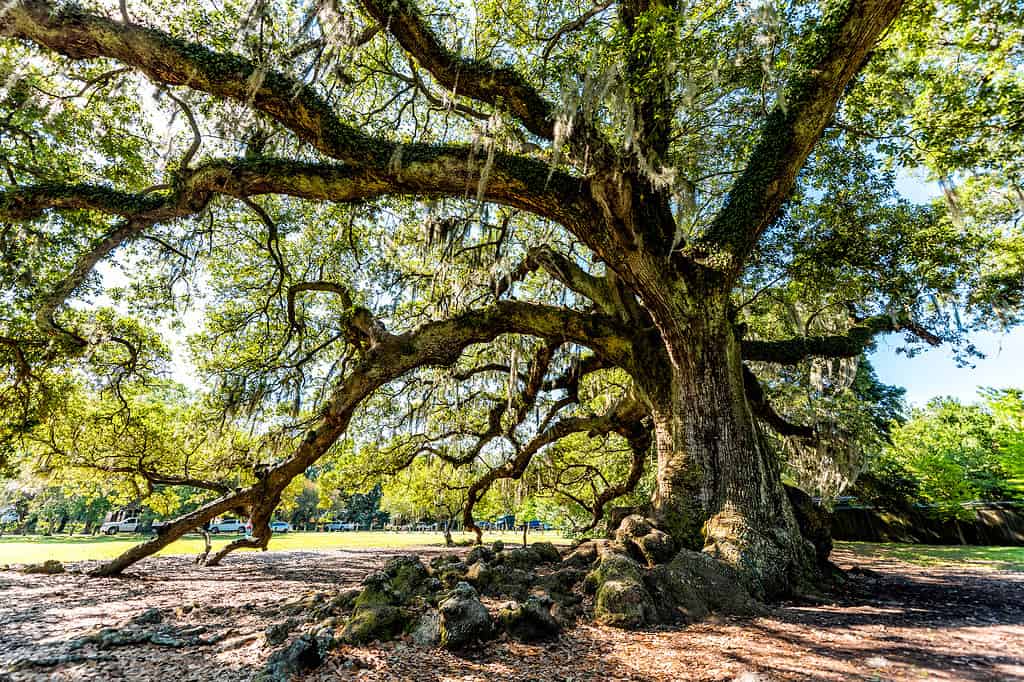
There are 54 National Historic Landmarks in Louisiana.
©Real Window Creative/Shutterstock.com
Louisiana is best known for Mardi Gras, Jazz music, Creole and Cajun food, and historical architecture. The state is home to approximately 4.6 million people covering 52,378 square miles. Located in the southeastern United States on the Gulf of Mexico, the state is where many French immigrants and African slaves settled.
With such an interesting history, one would imagine the state has an abundance of historical landmarks—and Louisiana definitely does! However, the majority of the best landmarks are located in New Orleans. If you plan to visit Louisiana for a historical excursion, start in Baton Rouge, and then round out your trip in New Orleans.
In total, Louisiana has 45 National Historic Landmarks, but 10 are the coolest and worth adding to your travel bucket list. Let’s take a journey across New Orleans and other pockets of history in the state to see which landmarks are worth checking out!
10. Louisiana State Capitol (Baton Rouge)

©Sean Pavone/Shutterstock.com
The Louisiana State Capitol is located in downtown Baton Rouge. The capitol houses the Louisiana State Legislature, which includes the House of Representatives and the Senate. Louisiana’s governor is also located in the Capitol building. The Capitol building is the seventh tallest building in Louisiana and the tallest skyscraper in Baton Rouge. Coming in at 450 feet tall with 34 stories, the building is also the tallest State Capitol building in the United States. The building is located on 27-acres, which is also home to the capitol’s gardens.
In 1928, the newly elected Governor of Louisiana, Huey Long set forth with having a new capitol building constructed. The building was a symbol of Louisiana’s way forward from the culture of the economic elite. The building’s construction took 14 months and was completed by 1931. In 1978, the Louisiana State Capitol was listed on the National Register of Historic Places. Four years later, the capitol building was designated a National Historic Landmark.
On September 8, 1935, Goverlong was assassinated. After an altercation, Dr. Carl Weiss shot Governor Long inside the State Capitol building. Long was interned on September 13 and he was laid to rest in Capitol grounds. His statue faces the Capitol.
Why You Should Visit the Louisiana State Capitol
The Louisiana State Capitol is a vision of Governor Long’s dreams for the state. Although his assassination cut his work short, the State Capitol building has served the state for nearly a century. Visitors are welcome daily, between the hours of 8:00 a.m. – 4:30 p.m.
Seeing as the building is the tallest capitol in the nation, it’s a must to check out the Observation Deck on the 27th floor. From here, you can see the city of Baton Rouge, the Capitol Gardens, and the Capitol Lakes. Some say that you can see other parts of Louisiana on a clear day.
Once you visit the Louisiana State Capitol, be sure to check out other nearby attractions in Baton Rouge. There’s the Old State Capitol, the Old Governor’s Mansion, and the Magnolia Mound—all glimpses at a past version of Louisiana.
9. Old Louisiana State Capitol

The Old Louisiana State Capitol was home to the state legislature until the new capitol opened.
©CrackerClips Stock Media/Shutterstock.com
After you’ve visited the current Louisiana State Capitol, take a jaunt over to the Old Louisiana State Capitol. Also known as the State House, this historic government building now serves as a museum. It housed the Louisiana State Legislature from the mid-nineteenth century until 1932.
The Old Louisiana State Capitol looked and functioned like a castle. Some locals still refer to it as the Louisiana Castle or the Castle of Baton Rouge. The building was added to the National Register of Historic Places in 1973, a year later, it was designated a National Historic Landmark.
Why You Should Visit the Old Louisiana State Capitol
It’s a castle. What more do you need? The Old Louisiana State Capitol has a stained glass dome that is worthy of a visit. Historians gather that the building was constructed between 1847 and 1852. From its location near the Mississippi River, the Old State Capitol looks like a medieval fortress. The interior has marble and a cast-iron spiral staircase. All reasons to visit, right?
8. USS Kidd
After completing your tour of the State Capitol buildings from past and present, head down to the USS Kidd. The USS Kidd (DD-661) is a Fletcher-class destroyer. The ship is the six-hundred-sixty-first destroyer built by the United States Navy. The ship is named after Rear Admiral Isaac C. Kidd, who died in 1941 while on the USS Arizona during Pearl Harbor. The USS Kidd launched on February 28, 1943 and commissioned on April 23, 1943. In 1966 the USS Kidd was designated a National Historic Landmark.
Why You Should Visit the USS Kidd
The USS Kidd is the only surviving US destroyer still in its World War II configuration. The ship is also considered to be the best-preserved World War II destroyer. The ship has a variety of artifacts spanning generations and representing different parts of naval history.
7. United States Custom House (New Orleans)

The U.S. Custom House is conveniently located on the Mississippi River.
©f11photo/Shutterstock.com
The U.S. Custom House is one of the oldest buildings in the United States, and it’s also one of the most important federal buildings in the South. The federal government commissioned its construction during the nineteenth century, and this granite masterpiece took 33 years to build. Construction began in 1848.
Louisiana had the goal of becoming an important port city in the United States. As a result of this, the Custom House was built near the Mississippi River. Being near the waterway, New Orleans saw increased trading during the 1840s.
Why You Should Visit the United States Custom House
According to legend, the U.S. Custom House had bales of cotton as its foundation. However, the foundation of the Custom House is a combination of cement, shells, and brick. After settling 11 feet below grade, which resulted in some reconfiguration during construction. It is possible that the cotton legend originated from the fact that cotton was used to “caulk” the wood joints. These joints were used to hold back the soil while the foundation was being constructed. The architecture and size of the Custom House is reason alone to visit.
6. Longue Vue House and Gardens (New Orleans)
Longue Vue is the former home of Edgar Stern and Edith Rosenwald Stern. The historic house museum has seven associated gardens. Longue Vue House and Gardens is located in the Lakewood neighborhood of New Orleans. The mansion known as Longue Vue is actually the Sterns’ second house. The original house and subsequent gardens began in 1924.
The Sterns eventually became disappointed with their house because it did not provide an adequate view of the gardens. The first house was moved, and in 1939, the second home was erected. In 1991, Longue Vue was listed on the National Register of Historic Places. By 2005, it was declared a National Historic Landmark.
Why You Should Visit Longue Vue House and Gardens
Longue Vue embodies 20th-century architecture, and with eight acres of gorgeous landscaped gardens, a tour of the home will not disappoint. The gardens feature Spanish Court stylings, an array of fountains, and a rectangular pool directly in front of the mansion. Longue Vue is one of the last examples of Country Era Place homes in the Deep South.
5. Hermann-Grima House (New Orleans)
The Hermann-Grima House is a historic home in the French Quarter of New Orleans. This National Historic Landmark is one of the best-preserved examples of Federal-style architecture in the French Quarter. The house was constructed during the nineteenth century. Both the Hermann and Grima families lived in the house at some point during this time period. In 1924, the Christian Women’s Exchange purchased the Hermann-Grima House which served as a rooming house for women until 1975. The house became a museum in the late 1970s.
Why You Should Visit the Hermann-Grima House
As an excellent example of Federal style architecture, the home offers a few open-hearth kitchens. From November through April, you can check out a cooking demonstration in the kitchen. The house also has the only original stable in the French Quarter. While walking through the house, visitors will feel transported back to the nineteenth century. You can also expect to learn about the owners and the enslaved people who lived/worked on the property. The rooms are all furnished with period pieces.
The Hermann-Grima Courtyard is also one of the largest in the French Quarter. When the house was first built, the courtyard was actually much larger. Thanks to research conducted by the Women’s Exchange, the home honors the architectural and household furnishings of its time.
4. Garden District (New Orleans)

The oldest living oak is located in the Garden District.
©krblokhin/iStock via Getty Images
The Garden District is part of uptown New Orleans, which geographically speaking, means it is upriver from the Mississippi River. Although the Garden District is located “uptown,” it’s not actually part of the Uptown neighborhood. The neighborhood was settled by English-speaking Americans during the early nineteenth century. These Americans were eager to separate themselves from the French-speaking New Orleans.
Why You Should Visit the Garden District
Today, the Garden District is home to historic mansions, high-end shopping on Magazine Street, and streets lined with oak trees. Wander the streets, and pop into The Rink, a collection of shops and a cafe housed in what used to be a skating rink.
3. Jackson Square (New Orleans)

The statue of Andrew Jackson is directly in front of the St. Louis Cathedral.
©Larry Gibson/iStock via Getty Images
Originally called the “Place d’Armes,” the square was later named after Andrew Jackson. His efforts during the Battle of New Orleans made him an important figure in Louisiana history. As the square was the backdrop to many historical events, Jackson Square was named a National Historic Landmark in 1960. It’s also the site where the 1803 Louisiana Purchase designated the state United States territory.
Jackson Square mimics the architectural style of Place des Vosges in Paris, France. The statue of Andrew Jackson was erected in 1856. The statue honors the seventh president’s work in New Orleans. The famous landmark faces the Mississippi River. The statue is surrounded by other historic buildings, such as St. Louis Cathedral. The landmark is also near the Lower and Upper Pontalba Apartments, which are the oldest apartments in the United States.
Why You Should Visit Jackson Square
Located near other historic landmarks, Jackson Square provides easy access to other pivotal pieces of Louisiana history. With 2.5 acres of space, the park welcomes over 2 million visitors annually. The park is most known as being an open-air artist colony where artists gather to share their work on the square. Directly across the street from the square, you’ll find Café Du Monde. Grab a beignet and coffee and then take a stroll around Jackson Square.
2. Lafitte’s Blacksmith Shop (New Orleans)

Plan on a visit to Lafitte’s and grab a frozen drink.
©Limeyistocker/iStock via Getty Images
Lafitte’s Blacksmith Shop is one of the oldest surviving structures in New Orleans. Jean Lafitte (or John) owned a business at the property sometime during the 19th century, but the property was more than likely constructed as a house during the 1770s.
With little to no historical evidence or documentation, pinpointing Jean Laffite’s ownership of the property was a little tricky. Many historians assume that Lafitte used the shop to sell contraband. However, there is a possibility the property was used as a blacksmith shop. In 1970, Lafitte’s Blacksmith Shop became a National Historic Landmark.
Why You Should Visit Lafitte’s Blacksmith Shop
Many New Orleans locals acknowledge the sketchy history of Lafitte’s Blacksmith Shop as typical of New Orleans culture. Some part history, some part fiction is very New Orleans, and the embellishments to the past make the area so rich and vibrant. Today, Lafitte’s Blacksmith Shop is a bar that offers beer and frozen drinks. There are rumors about the bar being haunted. You might want to visit just to see for yourself.
1. Vieux Carré Historic District (New Orleans)

The French Quarter is home to gorgeous, vibrant architecture.
©rmbarricarte/iStock via Getty Images
The Vieux Carré Historic District is the center of New Orleans. The French name of the historic district translates to “Old Square,” which is evident in the city’s founding, which dates back to 1718. Jean-Baptiste Le Moyne de Bienville founded New Orleans, and he designed the city around the Vieux Carré.
Vieux Carré, also known as the French Quarter, barely rests above sea level. As the oldest neighborhood in New Orleans, the French Quarter is a symbol of the city’s complex and unique culture and history. This area suffered minimal damage during Hurricane Katrina because of its distance from the levees.
Why You Should Visit the Vieux Carré Historic District
As the oldest neighborhood in New Orleans, the Vieux Carré Historic District is home to the French Market, rich architecture, and historic museums. Just wandering the streets will reveal exciting new discoveries, whether it’s food, drink, or history. Pop into some interesting stores, or try a new type of cuisine. You might be inspired to grab a seat and just people-watch.
Visiting Louisiana
The majority of the coolest landmarks are located in New Orleans, Louisiana. You might want to plan your visit with a starting point in Baton Rouge, the state’s capital. Then, wrap up your historical adventures in New Orleans. It’s about a 1.5-hour drive from Baton Rouge to New Orleans and along the way, you can take in some of the natural wonders of the state.
While the state has a plethora of other National Historic Landmarks, if you’re planning a visit to Louisiana, we recommend checking out New Orleans for a taste of excellent food, yes, but also of great culture and rich history.
Summary of the 10 Coolest National Historic Landmarks in Louisiana
| Rank | Historic Landmark | Location |
|---|---|---|
| 1 | Vieux Carré Historic District | New Orleans |
| 2 | Laffitte’s Blacksmith Shop | New Orleans |
| 3 | Jackson Square | New Orleans |
| 4 | Garden District | New Orleans |
| 5 | Hermann-Grima | New Orleans |
| 6 | Longue Vue House and Gardens | New Orleans |
| 7 | U.S. Custom House | New Orleans |
| 8 | USS Kidd | Baton Rouge |
| 9 | Old Louisiana State Capitol | Baton Rouge |
| 10 | Louisiana State Capitol | Baton Rouge |
The photo featured at the top of this post is © Real Window Creative/Shutterstock.com
Thank you for reading! Have some feedback for us? Contact the AZ Animals editorial team.






